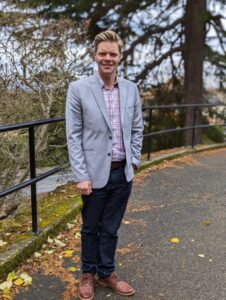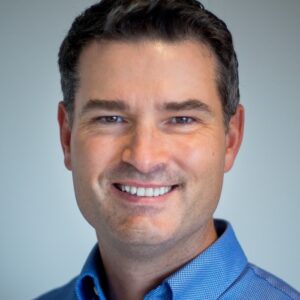During the October 15 municipal elections, the residents of Saanich and Oak Bay, which Camosun College’s campuses are on, elected mayors who made student issues related to housing availability and affordability, as well as transit and active transportation, a priority during their campaigns.
Saanich voted in new mayor Dean Murdock, a former Camosun student and Political Science instructor, while Oak Bay mayor Kevin Murdoch ran unopposed and was acclaimed for a second term in office.
Saanich’s Murdock says that his recent experience as an instructor gave him insight into the challenges facing students today, which he says are not much different than when he was a student but are certainly more intense, especially relating to housing within the municipality and region.
“I think more recently having the opportunity to teach class at Camosun and hearing from students has been helpful in understanding and getting the benefit of their perspective on what are really some very challenging issues that students face,” says Murdock, “just confronting the cost of living, studying, and working in this community and how difficult that can be for students.”

Oak Bay’s Murdoch says that issues relating to housing and affordability are most pressing for students right now.
“I think the general issues of housing and affordability are the two biggest issues that I’ve heard from students,” he says, “related to rental and housing availability as well as the cost of them and the affordability of life in general in our high inflationary environment.”
Murdoch admits that there’s not much a municipality can do to address affordability as it’s largely driven by provincial and federal policies. He says that a key part of the policy that was moved forward by the previous Oak Bay council that he would like to continue concerns infill housing, which would increase housing stock with an eye toward driving housing market prices down with more availability. This could help students access the market with rentals or purchases once they start their careers.
“The general affordability [issue] doesn’t come under our bailiwick so we’re really looking at the housing one,” he says. “From an outgoing council perspective the two big tackles were secondary suites and infill housing—being other housing forms within single-family neighbourhoods like townhouses and garden suites.”
While the entire region faces rising housing costs, Saanich’s Murdock says the impact he sees for students is that they must accept living in undesirable locations, often far away from their campus or place of work.
“It is not something that students face alone, but I think students are more likely to be renters in the community and we know that the scarcity of available rentals has contributed to a significant rise in the cost of renting,” says Murdock. “Because of that scarcity, it’s students who are often having to live in places that are not ideal for their circumstances, but it’s what’s available or what they can afford… And I think this has been exacerbated over the course of the recent years and we’re not keeping up with demand, and we’re certainly not keeping up with purpose-built student rentals.”
Murdock mentioned purpose-built student rentals several times during the election campaign when speaking about student issues, including using space in the McKenzie corridor that could facilitate purpose-built student housing in addition to amenities within walking distance. Both mayors also acknowledge the need for the schools to address on-campus housing alongside the private-housing market, with support from the provincial government, who has committed to helping to create 8,000 student beds on campuses throughout the province by 2028.
“What we’re seeing is students are having to find rental housing that is not appropriate for their needs or their circumstances,” says Murdock, “and what we need, I think, is to focus on creating more appropriate student housing, so whether that is working with the university or Camosun or both to have that built on campus, or if we are looking to the private sector for more building in those [areas] that are the transportation corridors for the campuses, I think that we need to look at a strategy that allows for both of those things to happen in tandem.”

“[Oak Bay council] has been clear over the last term that we would really like to see some more housing being built on campuses,” adds Oak Bay’s Murdoch. “In fact, there’s a portion of Camosun’s Lansdowne campus that is in Oak Bay boundaries—the parking lots [on Foul Bay Road]—and you’ve got, similarly, the southern portion of University of Victoria lands that are within Oak Bay, and we would really like to see them develop additional housing forms on those lands. We see this as a partnership. I think [the schools, council, and province would] have shared goals on that and I think we can help the institutions by speeding up and making the application process as clear as possible. That speed-up really helps the cost of their process, so I think that’s work that can be done expediently to see what the post-secondary education housing needs are and how [council] can help facilitate that.”
Transit within their communities and within the broader region were also identified as issues that concerned students in the election. Both mayors acknowledge the work that has been done so far and have committed to develop policies that encourage transit usage by making the system more efficient for all users. This is especially important for students who are being forced to look further away from campus for affordable housing and have to rely on public transit.
“Saanich is the largest municipality in the region, we represent the largest population, and I think because of that we need to play a leading role in creating improvements to transit service and working with our regional partners to create a transportation authority that would help us with creating service improvements and leveraging senior government investment in transit for the capital region,” says Saanich’s Murdock. “We have five MLAs representing the capital region who are in the provincial cabinet, so I think [there’s a] case to be made for paying attention to public transit in the CRD, we’ve got much more receptive ears at the provincial level, and I also think with the newly elected mayors and councils around the region, we have a significant opportunity to move forward and ask the province to consider something like a transportation authority to get better organized.”
Active transportation with routes and links to regional municipalities is also an issue important to students who often commute by bike. Oak Bay has been criticized in the past by local cycling groups for being slow to provide adequate and safe cycling infrastructure, which Murdoch admits to but he has committed to expanding the network and linking it with existing facilities in Saanich and Victoria, which border the municipality, within the next term.
“There’s a lot of work to be done to build out the core active transportation routes,” he says. “We’ve just increased the amount of money that is being allocated for that and the detailed design work is still being done, so I expect the majority of those corridors to be either completed or at least have a temporary completion attached to it, but some of that design work is contingent upon the village plan, which puts attention on the building as well as the transportation pieces, so I anticipate the majority of the primary corridors should be in place by the end of this term.”
Both mayors say that student issues are important to them and that their councils and are committed to remaining open to hearing from students over the course of their terms. Oak Bay’s Murdoch says that he hopes to see more student engagement over the next four years.
“Encourage people in your student group to pay attention [to municipal issues] because they are very important pieces that student input is helpful to have,” he says. “The voices are heard but we often do not get that feedback from the students.”
